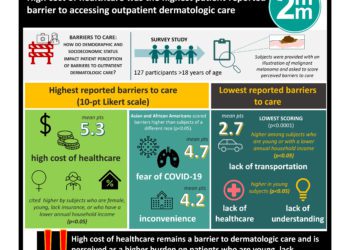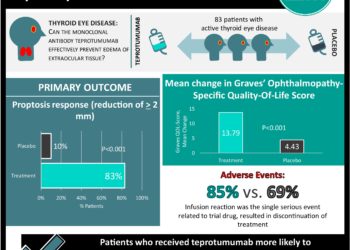Substantial thyroid disease reclassification under demographic-specific thyroid function reference intervals
1. In this cross-sectional study of thyroid function testing, applying new reference intervals based on age, sex, and race resulted in nearly half of participants with subclinical hypothyroidism being reclassified as normal.
2. Similarly, one-third of participants with subclinical hyperthyroidism were reclassified as normal.
Evidence Rating Level: 3 (Average)
Study Rundown: Current clinical reference intervals for thyroid function do not account for differences in age, sex, or race, all of which influence circulating thyroid function hormone levels. With laboratory testing of thyroid function being essential for confirming thyroid disease, this lack of specificity could result in misdiagnosis and mismanagement of thyroid disease. This study aimed to characterize differences in thyroid function between different patient populations. Regarding thyroid function indicators, advanced age was corelated with a skew toward higher thyroid stimulating hormone (TSH) and lower total triiodothyronine (TT3) levels. Women tended to have higher total thyroxine (TT4) levels compared with men, and White individuals had higher TSH levels compared with Black and Hispanic individuals. Using the new reference intervals for thyroid function resulted in lower prevalence of subclinical hypothyroidism among all age groups, with nearly half of individuals with subclinical hypothyroidism being reclassified as normal. Reductions in prevalence were particularly noticeable among women, White participants, and elderly Hispanic participants; however, prevalence increased among younger Black participants. Over thirty percent of participants with subclinical hyperthyroidism were also reclassified as normal, particularly women and Black participants; however, fewer White participants with subclinical hyperthyroidism were reclassified as normal. The generalizability of this study was limited by a lack of replicate measurements of thyroid function as well as an inability to assess the utility of new thresholds using clinical evidence of thyroid disease. Nonetheless, this study highlighted the impact of demographic factors when evaluating laboratory indicators of thyroid function.
Click to read this study in AIM
In-Depth [cross-sectional study]: This study aimed to determine age-, sex-, and race-specific reference intervals for thyroid function and assess how these intervals may affect classification of thyroid disease among patients. Participants were obtained from the American National Health and Nutrition Examination Survey (NHANES) and supplemented with data from a multicenter study in China. The NHANES cohort represented 72,852,160 men (median age, 42 years) and 75,487,863 women (median age, 44 years). Compared with men, women had a 4.1% higher weighted median level of TSH and a 5.1% higher weighted median level of TT4, but a 4.3% lower weighted median level of TT3. The Chinese data comprised 176,492 men (median age, 48 years) and 137,810 women (median age, 44 years); compared with men, women in this dataset had a 17.8% higher median TSH level but a 7.0% lower median level of free thyroxine (FT4) and a 9.1% lower median level of free triiodothyronine (FT3). In the NHANES cohort, increased age was associated with higher 97.5th percentile levels of TSH and a gradual decline in TT3 levels but stable TT4. Women had higher TSH levels compared with men, and White individuals had higher TSH levels compared with Black and Hispanic individuals. Using these reference intervals resulted in the reclassification of 132 (weighted 48.5%) participants with subclinical hypothyroidism and 80 (weighted 31.2%) participants with subclinical hyperthyroidism as normal. More women were reclassified from subclinical hypothyroidism (56.3% vs. 39.3%) or subclinical hyperthyroidism (37.0% vs. 23.8%) to normal compared with men. Overall, this study suggested that age-, sex-, and race-specific reference intervals for thyroid function may result in significant recategorization of patients’ disease status.
Image: PD
©2025 2 Minute Medicine, Inc. All rights reserved. No works may be reproduced without expressed written consent from 2 Minute Medicine, Inc. Inquire about licensing here. No article should be construed as medical advice and is not intended as such by the authors or by 2 Minute Medicine, Inc.







